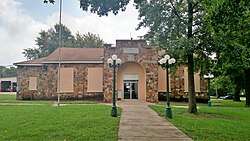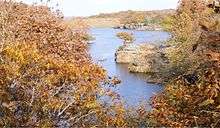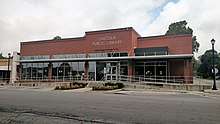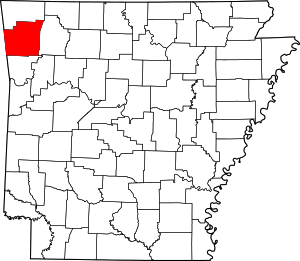Lincoln, Arkansas
Lincoln is a city in Washington County, Arkansas, United States. The population was 2,249 at the 2010 census. It is part of the Northwest Arkansas metro area.
Lincoln, Arkansas | |
|---|---|
 Lincoln City Square | |
| Nickname(s): Apple Capital of Arkansas[1] | |
 Location of Lincoln in Washington County, Arkansas. | |
| Coordinates: 35°56′54″N 94°25′26″W | |
| Country | United States |
| State | Arkansas |
| County | Washington |
| Incorporated city | November 23, 1907 |
| Named for | Abraham Lincoln |
| Government | |
| • Type | Mayor-council |
| • Mayor | Doug Hutchens |
| Area | |
| • City | 2.89 sq mi (7.47 km2) |
| • Land | 2.86 sq mi (7.40 km2) |
| • Water | 0.03 sq mi (0.07 km2) |
| Elevation | 1,473 ft (449 m) |
| Population (2010) | |
| • City | 2,249 |
| • Estimate (2019)[3] | 2,481 |
| • Density | 868.09/sq mi (335.18/km2) |
| • Metro | 534,904 |
| Time zone | UTC−6 (Central (CST)) |
| • Summer (DST) | UTC−5 (CDT) |
| ZIP code | 72744 |
| Area code | 479 |
| FIPS code | 05-39970 |
| GNIS feature ID | 0077500 |
| Website | www.lincolnarkansas.com |
| NWA metro population as of 2019[4] | |
History
Establishment
The area around Lincoln first saw white settlement in the late 1820s. It was first known as Blackjack after the blackjack oaks used to build the first schoolhouse. Joseph Carter built the first store in the area in 1874, still known as Blackjack. A nearby community on Beaty Mountain known as Mt. Hayes was settled in 1877. Starr Hill Township was also organized in the area during this period. The settlements drifted together and continued to grow until applying for a post office in 1884 within Carter's store under the name Georgetown.[5] The name was rejected; the postal service not wanting to duplicate Georgetown in White County, Arkansas (or Georgetown, Madison County, Arkansas). Carter submitted Lincoln as the new name. He said he chose the name seemingly at random, having "seen it on a box", but others were skeptical that Carter had wanted to name the community for Abraham Lincoln all along, as he was a "Republican from the North". Local acceptance for the name Lincoln was slow during the Reconstruction era following the bitter Civil War.[6]
The settlement remained unincorporated until the St. Louis–San Francisco Railway (commonly called the Frisco) planned a branch line (the Ozark and Cherokee Central Railway [O&CC]) between Fayetteville and Oklahoma. The right-of-way acquisition process brought a railroad agent through town, and he platted a town on 22 acres (8.9 ha) south of the proposed railroad in 1903, but modified the plat in 1907. Following this plat, the city of Lincoln was incorporated on November 23, 1907.[7]
On August 3, 1919, Black veteran Clinton Briggs was lynched as part of the Red Summer of 1919.
Geography
Lincoln is located at 35°56′54″N 94°25′26″W (35.948466, -94.423920).[8] According to the United States Census Bureau, the city has a total area of 2.87 square miles (7.4 km2).
Lincoln is about 25 miles southwest of Fayetteville and approximately eight miles east of the Arkansas-Oklahoma border.
Protected areas
Lincoln Lake, a few miles north of the city, is a 400-acre (160 ha) park surrounding the 90-acre (36 ha) municipally-owned lake formerly used for water supply. The park offers 8 miles (13 km) of hiking and mountain biking trails, fishing, and non-motorized boating.[9]
Region
The Northwest Arkansas region consists of three Arkansas counties: Benton, Madison, and Washington. The area had a population of 347,045 at the 2000 census which had increased to 463,204 by the 2010 Census (an increase of 33.47 percent). The region does not consist of the usual principal-city-with-suburbs morphology. The principal cities retain individual identities, but have grown together along Interstate 49 (I-49). For more than the last decade, Northwest Arkansas has been one of the fastest-growing regions in the United States.[10]
Demographics
| Historical population | |||
|---|---|---|---|
| Census | Pop. | %± | |
| 1910 | 292 | — | |
| 1920 | 534 | 82.9% | |
| 1930 | 687 | 28.7% | |
| 1940 | 720 | 4.8% | |
| 1950 | 771 | 7.1% | |
| 1960 | 820 | 6.4% | |
| 1970 | 1,023 | 24.8% | |
| 1980 | 1,422 | 39.0% | |
| 1990 | 1,460 | 2.7% | |
| 2000 | 1,752 | 20.0% | |
| 2010 | 2,249 | 28.4% | |
| Est. 2019 | 2,481 | [3] | 10.3% |
| U.S. Decennial Census[11] | |||
2000 Census
As of the 2000 United States Census[12], there were 1,752 people, 723 households, and 472 families residing in the city. The population density was 983.2 people per square mile (380.0/km2). There were 798 housing units at an average density of 447.8 per square mile (173.1/km2). The racial makeup of the city was 91.78% White, 2.57% Native American, 0.06% Asian, 2.57% from other races, and 3.03% from two or more races. 5.08% of the population were Hispanic or Latino of any race.

There were 723 households out of which 29.7% had children under the age of 18 living with them, 50.2% were married couples living together, 12.0% had a female householder with no husband present, and 34.7% were non-families. 30.8% of all households were made up of individuals and 17.0% had someone living alone who was 65 years of age or older. The average household size was 2.42 and the average family size was 3.00.
In the city, the age distribution of the population shows 26.7% under the age of 18, 8.6% from 18 to 24, 26.7% from 25 to 44, 21.3% from 45 to 64, and 16.8% who were 65 years of age or older. The median age was 35 years. For every 100 females, there were 88.6 males. For every 100 females age 18 and over, there were 84.1 males.
The median income for a household in the city was $27,639, and the median income for a family was $37,102. Males had a median income of $26,860 versus $18,958 for females. The per capita income for the city was $14,232. About 12.7% of families and 15.8% of the population were below the poverty line, including 18.5% of those under age 18 and 11.8% of those age 65 or over.
Government and politics
Mayor–city council
Lincoln operates within the mayor-city council form of government. The mayor is elected by a citywide election to serve as the Chief Executive Officer (CEO) of the city by presiding over all city functions, policies, and ordinances. Once elected, the mayor also allocates duties to city employees. The Lincoln mayoral election takes place during the United States midterm elections. Mayors serve four-year terms and can serve unlimited terms. The city council is the unicameral legislative of the City, consisting of eight city council members. Also included in the council's duties is balancing the city's budget and passing ordinances. Two city council members are elected from each of the city's four wards.
Human Resources
Education
Primary and secondary education
The community is served by the Lincoln Consolidated School District.[13] Successful completion of the curriculum leads to graduation from Lincoln High School. The high school and athletics complex were built in 2012 for $16.2 million.[14] The district briefly operated a district conversion charter school known as the Lincoln Academic Center of Excellence until 2012.[15]
Higher education
Lincoln does not contain any higher education institutions, but is in proximity to the University of Arkansas in Fayetteville and Northwest Arkansas Community College Washington County Campus in Springdale.
Library

Lincoln Public Library was demolished and rebuilt thanks to a bond, grants, and in-kind services. It is 10,200+ square feet, features 108 computers, tablets, and laptops. The public library has two meetings rooms, a demonstration kitchen, genealogy section and free internet extending into the square. The library is a member of the Washington County Library System.
Public safety
The Lincoln Police Department is the primary law enforcement agency in the city. The department has five officers as of 2018.[16]
Superseding district court jurisdiction is the 4th Judicial Circuit Court, which covers Washington and Madison counties.[17] The 4th Circuit contains eight circuit judges, elected to six-year terms circuitwide.
Culture
Lincoln is home to the Arkansas Country Doctor Museum, which includes a collection of medical instruments and personal artifacts from the 1930s to 1980s.
Annual cultural events
Lincoln is home to the Annual Arkansas Apple Festival, held every year the first weekend of October. For many years, it has attracted visitors to the area who come to see the arts and crafts of the Ozarks. Apple growing was once a major agricultural industry in Lincoln which has recently declined due to changing climate conditions and high costs of upkeep. In spite of the decline, Lincoln still hosts a successful Apple Festival that welcomes visitors and vendors from all over the nation. Serving free apple slices and a swig of Apple Cider to sightseers.
Local Apple farmers developed the following in the Area.
- Collins’ Red (aka Collins, Champion Red, Champion, Reagan's Red)—found by chance in a field near Lincoln; commercially propagated around 1886; a good colored fruit which keeps well, if kept properly
- Howard Sweet—the seedling is thought to have come from Earls Holt's Cane Hill nursery after the Civil War; grown near Cincinnati, Arkansas by Mr. Howard; a sweet, highly colored dessert apple; the tree has a heavy bloom
- Oliver Red (aka Oliver, Senator)—originated in Washington County; a yellow-skinned fruit washed with bright red; harvested in early September; a good dessert apple
Notable people
- Lance Eads, Republican member of the Arkansas House of Representatives for District 88 in Washington County; former resident of Lincoln[18]
- Ryan Mallett, former National Football League and Arkansas Razorbacks quarterback, attended elementary school at Lincoln Consolidated School District, where his father Jim was a coach, and his mother Debbie was a teacher.
References
- Martin, Becca Bacon (October 6, 2006). "Apples Still Reign Over Lincoln - Annual Festival Remembers Area's Boom Crop". The Morning News of Northwest Arkansas. Springdale, AR: Donrey Media Group. OCLC 1023077837.
- "2019 U.S. Gazetteer Files". United States Census Bureau. Retrieved June 30, 2020.
- "Population and Housing Unit Estimates". United States Census Bureau. May 24, 2020. Retrieved May 27, 2020.
- "Metropolitan and Micropolitan Statistical Areas Population Totals and Components of Change: 2010-2019". United States Census Bureau, Population Division. April 2019. Retrieved May 2, 2020.
- History of Benton, Washington, Carroll, Madison, Crawford, Franklin, and Sebastian Counties, Arkansas. Higginson Book Company. 1889. p. 320.
- Shiloh Museum of Ozark History (1989). History of Washington County, Arkansas. Springdale, Arkansas: Shiloh Museum of Ozark History. pp. 253, 260–261. OCLC 22705892.
- Davis, Boyce R.; Staff of the CALS Encyclopedia of Arkansas (June 19, 2018). "Lincoln (Washington County)". Encyclopedia of Arkansas. Little Rock, Arkansas: Butler Center for Arkansas Studies at the Central Arkansas Library System. OCLC 68194233. Retrieved May 10, 2020.
- "US Gazetteer files: 2010, 2000, and 1990". United States Census Bureau. 2011-02-12. Retrieved 2011-04-23.
- Kutter, Lynn (October 25, 2017). "Lincoln Lake a hidden gem". Washington County Enterprise-Leader. Farmington, AR: Northwest Arkansas Newspapers LLC. p. 7B. OCLC 401725818. Retrieved May 3, 2020 – via Newsbank.
- "Northwest Arkansas leads growth in state, 14th fastest-growing metro area nationwide – Talk Business & Politics". Talk Business & Politics. 2018-03-22. Retrieved 2018-05-06.
- "Census of Population and Housing". Census.gov. Retrieved June 4, 2015.
- "U.S. Census website". United States Census Bureau. Retrieved 2008-01-31.
- "About". Lincoln Consolidated School District. Retrieved 2019-08-29.
- Bernet, Brenda (July 31, 2011). "New school facilities built on tax increases". Northwest Arkansas Democrat-Gazette. WEHCO Media. p. 17. Retrieved May 2, 2020.
- Blad, Evie (August 14, 2012). "Lincoln forfeits charter with state - District works on independent plan". Northwest Arkansas Democrat-Gazette. WEHCO Media. p. 7. ISSN 1060-4332. OCLC 900475761. Retrieved May 2, 2020.
- Kutter, Lynn (December 5, 2018). "New Lincoln Police Chief". Washington County Enterprise-Leader. Farmington, AR: Northwest Arkansas Newspapers LLC. OCLC 401725818. Retrieved May 2, 2020.
- Circuit Court (Map) (Updated ed.). Little Rock, AR: Arkansas Secretary of State. October 16, 2014 [October 9, 2010] – via Arkansas Department of Transformation and Shared Services, Arkansas GIS Office.
- "Lance Ronaco Eads". intelius.com. Retrieved April 11, 2015.
